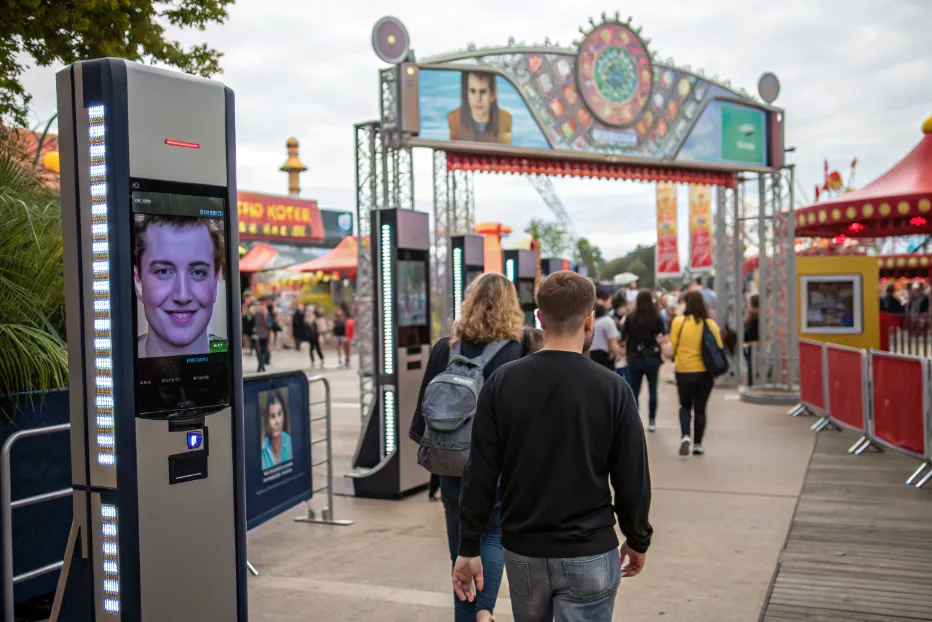The world of attractions is changing — fast. As the demand for immersive, personalized experiences grows, one technology is quietly taking center stage: facial recognition.
Long seen in airports and smartphones, facial recognition is now entering theme parks, museums, and interactive installations — helping create smoother entry processes, smarter content delivery, and unforgettable visitor journeys.
At Blow up Extreme, we stay at the forefront of innovation in entertainment. That’s why we’re watching this trend closely — because what’s happening now could shape the future of how we build and run inflatable experiences at large-scale events.
From Wristbands to Faces: A Smarter Way to Personalize
California-based tech company Mad Systems was one of the first to explore how facial recognition could be used inside attractions to personalize content. After testing QR codes, wristbands, and infrared badges, they discovered a simple truth: people already carry the perfect identifier — their face.
“No recharging, no sanitizing, no devices to lose. Just smart, frictionless interaction,” explains Mad Systems founder Maris Ensing.
Their solution, CheshireCat, runs on secure, offline servers that recognize faces within milliseconds — triggering personalized audio, subtitles, and visuals depending on a visitor’s age, language, and interest level.
Where It’s Already in Action
Major venues like Universal Studios and Changi Airport in Singapore are already rolling out facial recognition on a massive scale. In fact, millions of travelers have used it at Changi to check in, drop off bags, and board flights — cutting wait times by half.
At Universal Studios Florida, Beijing, and Islands of Adventure, guests can now choose to validate park entry via a photo rather than a fingerprint. This opt-in system also helps manage locker access and speed up Express lane entrances, while keeping data secure and short-term.
Universal has also filed patents for a new system that uses machine learning and facial data to monitor crowd flow, detect risky behavior, and even track alcohol consumption — creating smarter, safer parks.
Facial Recognition in Action: Where and Why It’s Used
| Attraction Type | How Facial Recognition Helps |
|---|---|
| Theme Parks | Faster entry, locker access, Express lane validation |
| Museums | Personalized exhibit content by age, language, or interest |
| Airports | Biometric passport checks, paperless boarding, luggage drop |
| Wildlife Parks & Zoos | Identifying animal species using image recognition |
| Educational Installations | Adaptive learning paths, avatars, and accessible content for diverse visitors |
Addressing Privacy Concerns
Of course, with technology comes responsibility. Facial recognition can raise valid concerns around privacy and data protection.
Mad Systems has addressed this by designing fully offline systems with no internet access and secure on-site servers. User data is automatically deleted daily, and nothing is shared or stored long-term.
At Universal Studios, guests can opt out of the service anytime, and digital images are stored for a maximum of six months (or one year at international locations). Transparency and choice are essential for building trust as this technology expands.
Beyond Humans: Recognizing Animals and Planes?
In a surprising twist, companies like Pigeon Tech are now using similar tools for animal and aircraft identification. Their gamified recognition systems are already in use at wildlife parks in Texas and France, and even at the Museum of Flight in Seattle — allowing visitors to scan, identify, and learn about what they’re seeing in real time.
Although they don’t yet distinguish between individual animals, developers say that capability is likely on the horizon.
What This Means for the Future of Attractions
Facial recognition is more than just a convenience — it’s becoming a bridge to hyper-personalized, intelligent experiences. Imagine inflatable attractions that adapt to each guest, delivering multilingual instructions, tailored challenges, or gamified progress tracking.
At Blow up Extreme, we’re watching how this space evolves — not to replace the fun, but to enhance it. The future of play might just start with a look in the mirror.

